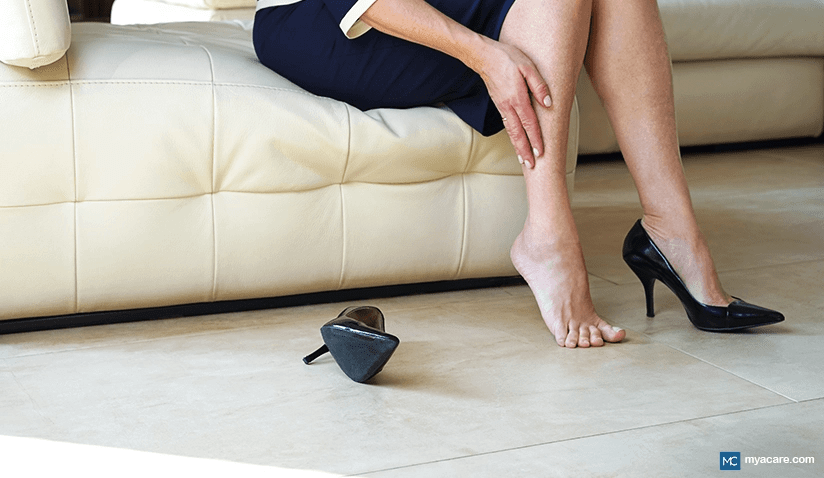Varicose Veins Symptoms, Causes, and Treatment

Varicose veins, or spider veins, happen when the small veins running under your skin become swollen, twisted, and congested with blood, making them clearly visible. The problem is very common, especially in women, with nearly 1 in every 4 adults having varicosities.
Varicose veins are most commonly seen in the legs, however, they can appear in different parts of your body. The problem arises due to a dysfunction in the veins themselves, which causes the blood to pool inside them. A lot of times, varicose veins cause no symptoms and are just a cosmetic matter. Nevertheless, many people can get calf and leg pain or discomfort if they have this condition.
Several risk factors, like obesity and female gender, have been associated with spider veins. The good news is that many effective and simple treatments are available to treat this annoying condition.
Why do Varicose Veins Appear?
Veins transport blood from all your body parts to your heart to be pumped, and they contain one-way valves that prevent blood from back flowing inside them. Muscles around the veins contract (when we walk, for example), and push the blood uphill. If the valves are working properly, the blood should be pushed from one valve to the other. However, when these valves become faulty for any reason, blood starts to pool in your veins instead of moving to your heart, and the veins become dilated and congested. The reason why this happens most commonly in your legs is gravity. Staying in the same position (standing or sitting) for long periods of time means that you won’t be using your leg muscles to push blood upwards from your legs to your heart. Subsequently, the static blood will start dilating your veins and ruining your valves.
You might be at higher risk of developing varicose veins if:
- You stand or sit for long periods of time
- You are a female
- You’re pregnant
- You’ve reached menopause
- You’re older than 50 years of age
- You’re obese
- Someone in your close family has varicose veins
What are the Symptoms of Varicosities?
People who have varicose veins mostly complain of their annoying appearance. They appear as blue or purple large misshapen vessels that bulge under the skin of your legs.
A lot of times, people with varicosities experience more uncomfortable symptoms, such as heaviness and pain in the legs, especially after standing up or sitting down for long periods of time. Some may even feel an itching sensation around the affected areas.
In more severe cases, varicose veins can cause some serious complications that would necessitate consulting with your treating physician. The skin might sometimes ulcerate, and an open wound is formed. If the deeper veins in your leg become congested, blood clots might form inside them, causing your leg to swell and become painful. Some varicose veins may become so congested that they rupture and bleed. If any of these symptoms happen, you should promptly let your physician know.
How Can You Prevent Varicosities From Forming?
Several preventive measures are recommended by doctors to prevent varicose veins from forming or reduce their size. Some simple lifestyle changes may be enough to help avoid this bothersome condition:
- Avoid standing or sitting for extended periods of time. If your work requires this, try taking breaks every now and then to move your legs and jump around.
- Lose those extra pounds. Extra weight means extra pressure against the blood flowing in your circulation.
- Exercise more: this improves your overall health and specifically the health of your blood vessels.
- Try using compression stockings if you must. These are sometimes recommended by doctors to help apply more pressure on your veins to prevent blood from pooling.
- Avoid tight pants that can block the blood from flowing upwards.
- Quit smoking, if you smoke. Smoking is bad for your health, and studies have shown a relation with developing varicosities.
What are the Available Treatments for Varicose Veins?
If lifestyle changes are not working for you, and your varicose veins are still causing your legs to swell and become painful, you can discuss one of many treatment options available with a dermatologist or vascular surgeon. Some of the available medical procedures to treat varicose veins:
- Surgical removal: the doctor performs a small incision, removes the dilated veins from under your skin, and sutures the wound.
- Sclerotherapy: it’s the injection of special chemicals that cause your vessels to shrink and close up.
- Laser therapy: your doctor will use light energy (laser) on your veins to shrink them. Usually, several treatment sessions are needed for the varicosities to fully disappear.
- Endovenous ablation: a catheter is inserted inside the enlarged vein, and it emits radiofrequency waves that should make your veins collapse.
The bottom line, varicose veins are a very common condition that’s usually not directly harmful to your health. Nevertheless, the large, tortuous, bluish-purple veins under your skin can cause pain and swelling, especially in your legs, and may be disfiguring, urging you to seek treatment. Making a few lifestyle changes, like exercising more, can help prevent varicosities. And if this fails, or you want a more rapid solution, you can discuss the various medical procedures available to treat varicose veins with your dermatologist or vascular surgeon.
To search for the best health providers for dermatology in Croatia, Germany, Greece, Italy, Malaysia, Singapore, Slovakia Spain, Thailand, The UAE, the UK, and the US, please use our free search engine.
To search for the best healthcare providers worldwide, please use the Mya Care search engine.
Dr. Mersad is a medical doctor, author, and editor based in Germany. He has managed to publish several research papers early in his career. He is passionate about spreading medical knowledge. Thus, he spends a big portion of his time writing educational articles for everyone to learn.
Sources:
Featured Blogs



